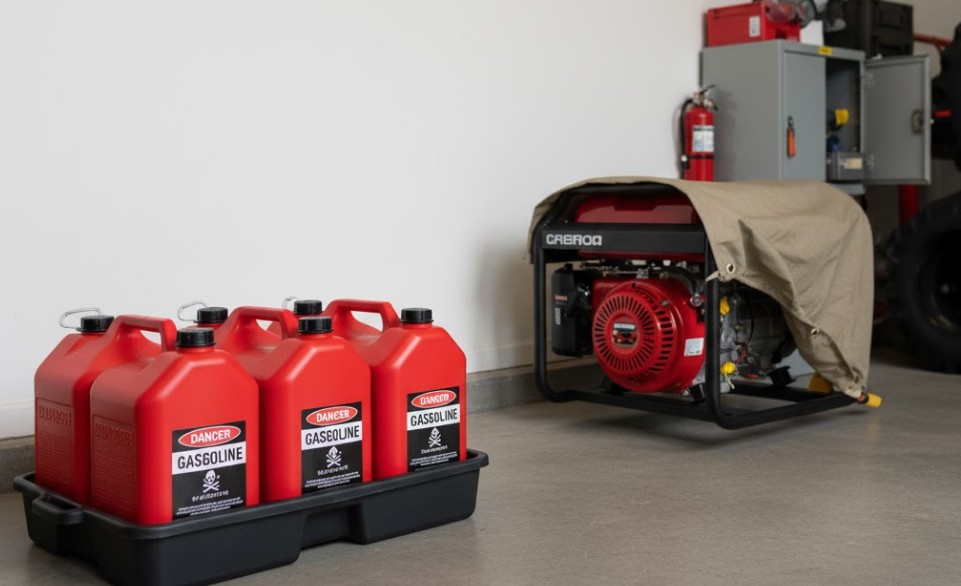In a world increasingly reliant on electricity, a power outage can quickly disrupt daily life. For many homeowners and businesses, a reliable generator is a crucial piece of emergency equipment. However, the generator itself is only as useful as the fuel that powers it. Storing fuel safely and correctly is not just about preparedness; it’s a critical safety issue. This comprehensive guide will walk you through the safe fuel storage practices for generators, ensuring you are ready for any emergency while protecting your property and family.

Why Proper Fuel Storage is Non-Negotiable
Fuel is a volatile and highly flammable material. Improper storage can lead to a host of dangers, including fire, explosion, and toxic fume inhalation. Furthermore, fuel degrades over time, which can damage your generator’s engine and compromise its performance when you need it most. Therefore, understanding and implementing the correct storage protocols is an essential part of generator ownership.
The Dangers of Neglecting Fuel Safety
- Fire and Explosion Risk: Gasoline vapors, in particular, can ignite easily, even from a small spark or pilot light.
- Health Hazards: Fumes from fuels like gasoline and diesel are toxic and should never be stored in living spaces.
- Equipment Damage: Stale fuel can gum up a carburetor or fuel injectors, leading to costly repairs or complete generator failure.
Understanding Your Generator’s Fuel Type
Generators operate on a variety of fuels, and each has unique storage requirements. The most common types are gasoline, diesel, and propane. Understanding the nuances of each is the first step toward safe fuel storage practices for generators.
Gasoline Storage: The Short-Term Necessity
Gasoline is the most common fuel for portable generators (Find the best portable generators here), primarily because it’s widely available. However, it is also the most volatile and has the shortest shelf life—typically only three to six months without a stabilizer.
Storage Container Essentials for Gasoline
- Use only EPA/CARB approved containers, typically red in color.
- Containers must be equipped with a flame arrester and a secure, tight-fitting cap.
- Never use glass or unapproved plastic containers.
Diesel Storage: The Long-Term Option
Diesel fuel is less volatile than gasoline and has a longer storage life, often up to 12 months, or even longer with proper treatment. It’s the preferred fuel for many whole house generators (Compare the best whole house generators), which require reliable, long-term energy reserves. The primary storage concern with diesel is the growth of bacteria and fungi (known as “diesel bug”) which can clog filters.
Storage Container Essentials for Diesel
- Use approved, typically yellow diesel fuel containers.
- Ensure the tank or container is kept as full as possible to reduce condensation, which introduces water and encourages microbial growth.
Propane (LP Gas) Storage: The Easiest to Maintain
Propane is stored under pressure in highly durable, specialized tanks. Unlike liquid fuels, propane has an virtually indefinite shelf life. This makes it an incredibly popular option for emergency power. The main concern with propane is the integrity and placement of the tank itself.
Propane Tank Safety
- Always store tanks outdoors, away from direct sunlight and heat sources.
- Ensure the tank is stored upright on a solid, level surface.
- Do not store propane tanks near windows, doors, or air conditioning units, as a leak could allow gas to enter the building.
The Three Pillars of Safe Fuel Storage
Regardless of the fuel type, safe fuel storage practices for generators revolve around three fundamental principles: Location, Container, and Maintenance.
1. Location, Location, Location: Where to Store Fuel
Where you store your fuel is arguably the most important factor in preventing accidents. Fuel must be stored in a location that is cool, dry, well-ventilated, and secured.
Never store any type of liquid fuel (gasoline or diesel) inside a home, basement, garage attached to a home, or near any ignition source such as a furnace, water heater, or appliance pilot light. Vapors are heavier than air and can travel along the floor to an ignition source, causing a flash fire.
The Ideal Storage Location:
- A detached shed or storage building designed for this purpose.
- At least 50 feet away from any ignition source and the main dwelling.
- The area should be secured against unauthorized access, especially from children.
2. The Right Container: Compliance and Construction
The container is the physical barrier between the volatile fuel and the outside world. Using the correct, approved container is a legal and safety requirement. For liquid fuels, look for containers that comply with standards set by the Environmental Protection Agency (EPA), the California Air Resources Board (CARB), and the Occupational Safety and Health Administration (OSHA). These regulations ensure the containers minimize accidental spills and vapor emissions. Large, permanent storage is often held in specialized fuel tank systems (Learn more about the components of a fuel tank).
Key Features of Approved Fuel Containers
Look for containers that are:
- Vapor-tight to prevent the release of flammable fumes.
- Clearly labeled with the type of fuel they contain (Gasoline, Diesel, Kerosene).
- Designed with an automatic shut-off nozzle to prevent overfilling and spillage.
- Made of durable, non-corroding material.
3. Fuel Maintenance: Stabilize and Rotate
Even the best location and container can’t stop the natural degradation of fuel. Safe fuel storage practices for generators include an active maintenance regimen to keep fuel fresh and your generator’s engine protected.
The Importance of Fuel Stabilizers and Treatments
For gasoline and diesel, a fuel stabilizer is your best friend. A quality stabilizer slows down the chemical oxidation process that leads to gum and varnish buildup. Always follow the manufacturer’s instructions for the correct ratio.
- Gasoline: Always add a stabilizer when storing for more than 30 days.
- Diesel: Use a biocide/fungicide treatment to combat microbial growth, especially for long-term storage.
The Fuel Rotation Schedule
The “First In, First Out” (FIFO) rule applies to fuel. Establish a rotation schedule to use older fuel in vehicles or other non-critical equipment and replace it with fresh stock.
- Gasoline Rotation: Aim to replace your stored gasoline every 6-12 months, even with a stabilizer.
- Diesel Rotation: Aim to replace your stored diesel every 12-18 months.
Legal and Regulatory Compliance for Fuel Storage
Fuel storage isn’t just a matter of common sense; it’s governed by strict regulations, particularly regarding the quantity you are allowed to store. These laws are typically set by the National Fire Protection Association (NFPA) and adopted by local fire codes.
Quantity Limits and Permitting
The quantity of fuel you can legally store without a special permit varies significantly by jurisdiction. As a general rule, storage of more than 25 gallons of gasoline for residential use often triggers regulatory oversight and may require professional-grade, stationary tanks. Always check with your local fire department or planning office to understand the specific maximum allowable quantity (MAQ) in your area. Failure to comply can result in fines and, more importantly, put your insurance coverage at risk in the event of an accident.
Emergency Preparedness for Spills
Despite the best precautions, spills can happen. An integral part of safe fuel storage practices for generators is having a spill containment plan.
- Keep an absorbent material (e.g., kitty litter, commercial spill pads) and a non-sparking shovel nearby.
- Ensure all fuel tanks and containers are stored in a secondary containment area—a tray or dike that can hold 110% of the volume of the largest container.
Fuel Transfer Safety: From Storage to Generator
The act of moving fuel is often when accidents occur. Take every precaution to minimize spillage and static electricity buildup.
- Turn Off the Generator: Always refuel a generator when it is cool and completely shut down. Refueling a hot engine is a major fire hazard.
- Grounding: When transferring fuel from a large, stationary tank, ensure all components (tank, pump, receiving container) are properly grounded to prevent static discharge.
- Siphoning: Never siphon fuel by mouth. Use a dedicated siphon pump.
Final Thoughts
Owning a generator brings peace of mind, but that peace is entirely dependent on having a readily available, high-quality fuel supply stored in the safest way possible. Safe fuel storage practices for generators should not be an afterthought; they are a continuous responsibility. By investing in the right containers, choosing a secure location, and maintaining a strict rotation and treatment schedule, you ensure that your generator will roar to life reliably when the lights go out, all while safeguarding your home and community from unnecessary risk. Stay safe, stay prepared.
Amranul is a highly experienced product review writer with a passion for helping readers make smart, informed purchasing decisions. Since 2018, he has specialized in thoroughly researching and analyzing a wide range of products to deliver honest, in-depth reviews. Amranul combines technical accuracy with clear, engaging writing to break down complex product features and highlight true user value. Look for his reviews to find reliable information and expert insights you can trust before you buy!





